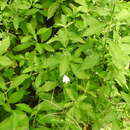en
names in breadcrumbs


నాగమల్లి పుష్పించే మొక్కలలో ఆస్టరేసి కుటుంబానికి చెందిన పూల మొక్క. దీని శాస్త్రీయ నామం: Rhinacanthus nasutus, దీనిని వివిధ భాషలలో snake jasmine, ( • Hindi: कबुतर का फुल kabutar ka phul, पालक जूही, Marathi: गजकर्णी gajkarni • Sanskrit: यूथिकापर्णी yuthikaparni అని పిలుస్తారు.[1] ఇవి చిన్న పొదలుగా భారతదేశమంతా విస్తరించాయి.
దీని భాగాలు తామర వ్యాధికి, పాముకాటుకు వైద్యంలో ఉపయోగపడుతుంది.[2]
నాగమల్లి పుష్పించే మొక్కలలో ఆస్టరేసి కుటుంబానికి చెందిన పూల మొక్క. దీని శాస్త్రీయ నామం: Rhinacanthus nasutus, దీనిని వివిధ భాషలలో snake jasmine, ( • Hindi: कबुतर का फुल kabutar ka phul, पालक जूही, Marathi: गजकर्णी gajkarni • Sanskrit: यूथिकापर्णी yuthikaparni అని పిలుస్తారు. ఇవి చిన్న పొదలుగా భారతదేశమంతా విస్తరించాయి.
Rhinacanthus nasutus, commonly known as snake jasmine,[2] is a plant native to tropical Asia and the western Indian Ocean. It is a slender, erect, branched, somewhat hairy shrub 1–2 m in height. The leaves are oblong, 4–10 cm in length, and narrowed and pointed at both ends. The inflorescence is a spreading, leafy, hairy panicle with the flowers usually in clusters. The calyx is green, hairy, and about 5 mm long. The corolla-tube is greenish, slender, cylindric, and about 2 cm long. The flowers is 2-lipped; the upper lip is white, erect, oblong or lancelike, 2-toothed at the apex, and about 3 mm in both length and width; and the lower lip is broadly obovate, 1.1-1.3 cm in both measurements, 3-lobed, and white, with a few, minute, brownish dots near the base. The fruit (capsule) is club-shaped and contains 4 seeds.[2]
It has been used in the treatment of snake bites.[3]
Rhinacanthus nasutus, commonly known as snake jasmine, is a plant native to tropical Asia and the western Indian Ocean. It is a slender, erect, branched, somewhat hairy shrub 1–2 m in height. The leaves are oblong, 4–10 cm in length, and narrowed and pointed at both ends. The inflorescence is a spreading, leafy, hairy panicle with the flowers usually in clusters. The calyx is green, hairy, and about 5 mm long. The corolla-tube is greenish, slender, cylindric, and about 2 cm long. The flowers is 2-lipped; the upper lip is white, erect, oblong or lancelike, 2-toothed at the apex, and about 3 mm in both length and width; and the lower lip is broadly obovate, 1.1-1.3 cm in both measurements, 3-lobed, and white, with a few, minute, brownish dots near the base. The fruit (capsule) is club-shaped and contains 4 seeds.
 Flower
Flower
Kiến cò (danh pháp hai phần: Rhinacanthus nasutus) là một cây thuộc Họ Ô rô (Acanthaceae). Cây cao 1–2 m. Thân cây có 6 góc tròn, thân và lá có lông rất mịn, lá có cuống dài 2-5mm, hai đầu thon, 5-6 cặp gân. Chùm tụ tán nhỏ, lá hoa nhỏ khoảng 2mm, đài cao 5mm, có lông trắng, vành trắng, ống dài 2 cm, môi trên cao 1 cm, môi dưới dài cỡ 1,5 cm, 2 tiêu nhị, noãn sào có 4 hạt.
Cây chứa một chất tương tự như axit chrysophanic. Rễ và lá dùng trị bệnh ngoài da, nhất là chứng hắc lào (lác đồng tiền).
Cây bạch hạc mọc hoang ở nhiều tỉnh miền Bắc Việt Nam. Còn thấy mọc ở Ấn Độ, Malaysia, Đông Châu Phi. Có khi được trồng làm cảnh.
Cây cao 1–2 m. Thân cây có 6 góc tròn, thân và lá có lông rất mịn, lá có cuống dài 2-5mm, hai đầu thon, 5-6 cặp gân. Chùm tụ tán nhỏ, lá hoa nhỏ khoảng 2mm, đài cao 5mm, có lông trắng, vành trắng, ống dài 2 cm, môi trên cao 1 cm, môi dưới dài cỡ 1,5 cm, 2 tiêu nhị, noãn sào có 4 hạt.
Bạch hạc được sử dụng để điều trị nhiều bệnh như chàm, Herpes, bệnh lao phổi, viêm gan, tiểu đường, cao huyết áp, và các loại bệnh ngoài da khác.[1] Nó cũng rất hữu ích trong điều trị rắn cắn.[2]
Bạch hạc được biết đến với tính chất chống oxy hoá của nó, nghiên cứu cho thấy nó có khả năng điều trị một số bệnh thoái hóa thần kinh - chứng mất trí, đột quỵ,, bệnh Huntington, bệnh Parkinson và bệnh Alzheimer [3][4][5][6]
Bạch hạc được sử dụng trong thuốc chống côn trùng như là một tác nhân tiềm năng để trừ muỗi vằn và muỗi culex.[7]
Chất chiết xuất của bạch hạc cho thấy có khả năng chống nấm, kháng khuẩn, kháng virut, chống ung thư, kháng viêm, chống tiểu đường và chống tăng huyết áp.[8][9][10][11][12][13]
Người ta thường dùng rễ cây, dùng tươi hay khô làm thuốc. Rễ tươi mới đào bẻ đôi để một lúc lâu sẽ có màu đỏ. Lớp vỏ ngoài dễ bong ra. Mùi hắc nhẹ, vị ngọt tựa mùi sắn rừng.
Mùa hái quanh năm, nhưng tốt nhất vào mùa đông. Đôi khi người ta chỉ dùng vỏ rễ. Có khi dùng cả lá.
Nhiều nơi người dân dùng rẽ cây bạch hạc chữa bệnh hắc lào và một số bệnh ngoài da như bệnh chốc lở (impetigo), bệnh mụn rộp loang vòng (herpes circiné), eczema mãn tính.
Dùng rễ tươi hay khô giã nhỏ, ngâm rượu hoặc ngâm dấm trong 7 đến 10 ngày. Rửa sạch các vết hắc lào rồi bôi thuốc này lên.
Có thể nấu thành cao để dùng.
Phương tiện liên quan tới Rhinacanthus nasutus tại Wikimedia Commons
Kiến cò (danh pháp hai phần: Rhinacanthus nasutus) là một cây thuộc Họ Ô rô (Acanthaceae). Cây cao 1–2 m. Thân cây có 6 góc tròn, thân và lá có lông rất mịn, lá có cuống dài 2-5mm, hai đầu thon, 5-6 cặp gân. Chùm tụ tán nhỏ, lá hoa nhỏ khoảng 2mm, đài cao 5mm, có lông trắng, vành trắng, ống dài 2 cm, môi trên cao 1 cm, môi dưới dài cỡ 1,5 cm, 2 tiêu nhị, noãn sào có 4 hạt.
Cây chứa một chất tương tự như axit chrysophanic. Rễ và lá dùng trị bệnh ngoài da, nhất là chứng hắc lào (lác đồng tiền).
灵芝草(学名:Rhinacanthus nasutus),又名灵枝草,为爵床科灵芝草属的植物。分布于印度、缅甸、中南半岛、泰国、印度尼西亚、菲律宾以及中国大陆的海南、云南等地,生长于海拔700米的地区,多生长在灌丛中或疏林下。[1]
白鹤灵芝(中国高等植物图鉴) 仙鹤灵芝草(广州)